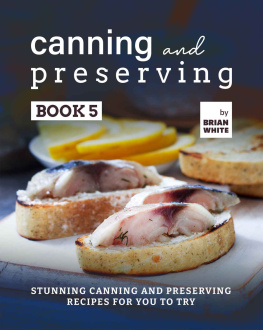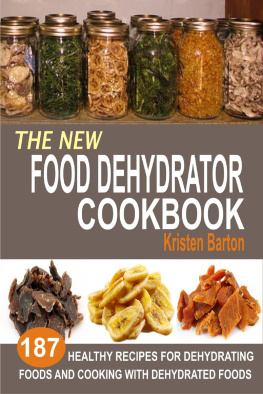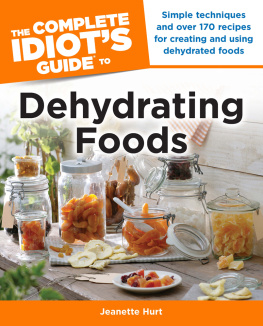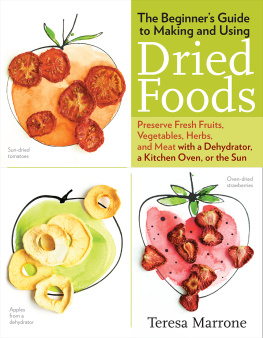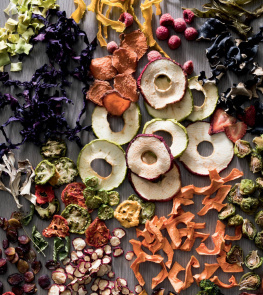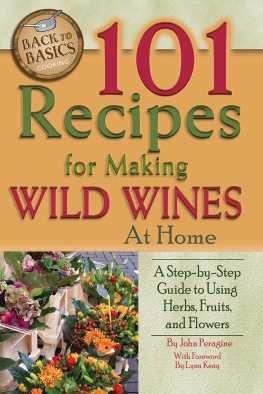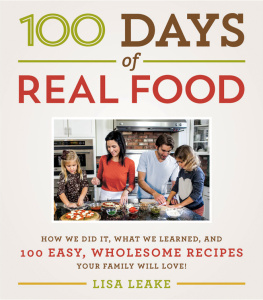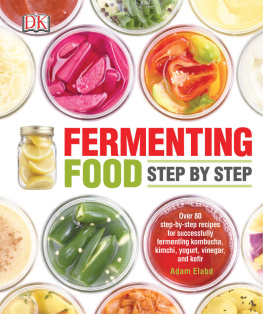Phyllis Hobson - Making & Using Dried Foods
Here you can read online Phyllis Hobson - Making & Using Dried Foods full text of the book (entire story) in english for free. Download pdf and epub, get meaning, cover and reviews about this ebook. year: 1994, publisher: Storey Publishing, LLC, genre: Home and family. Description of the work, (preface) as well as reviews are available. Best literature library LitArk.com created for fans of good reading and offers a wide selection of genres:
Romance novel
Science fiction
Adventure
Detective
Science
History
Home and family
Prose
Art
Politics
Computer
Non-fiction
Religion
Business
Children
Humor
Choose a favorite category and find really read worthwhile books. Enjoy immersion in the world of imagination, feel the emotions of the characters or learn something new for yourself, make an fascinating discovery.

- Book:Making & Using Dried Foods
- Author:
- Publisher:Storey Publishing, LLC
- Genre:
- Year:1994
- Rating:5 / 5
- Favourites:Add to favourites
- Your mark:
- 100
- 1
- 2
- 3
- 4
- 5
Making & Using Dried Foods: summary, description and annotation
We offer to read an annotation, description, summary or preface (depends on what the author of the book "Making & Using Dried Foods" wrote himself). If you haven't found the necessary information about the book — write in the comments, we will try to find it.
Dry and store fruits, vegetables, grains, meats, and herbs with these simple, step-by-step instructions. Includes dozens of recipes and plans for building your own food dryer.
Making & Using Dried Foods — read online for free the complete book (whole text) full work
Below is the text of the book, divided by pages. System saving the place of the last page read, allows you to conveniently read the book "Making & Using Dried Foods" online for free, without having to search again every time where you left off. Put a bookmark, and you can go to the page where you finished reading at any time.
Font size:
Interval:
Bookmark:
Making & Using
DRIED FOODS
DRIED FOODS
PHYLLIS HOBSON

The mission of Storey Publishing is to serve our customers by publishing practical information that encourages personal independence in harmony with the environment.
Edited by Amanda R. Haar
Revised for Second Edition by Joann Tarbox
Cover design by Cindy McFarland
Text design by Greg Imhoff
Cover illustration Copyright 1994 by Sara Love
Design assistance and production by Andrea Gray
Line drawings by Wendy Edelson, Brigita Fuhrmann, and Mary Rich
Indexed by Nan N. Bladgett, Wordability
1994 by Storey Publishing, LLC
Originally published in 1983 as Garden Way Publishings Guide to Food Drying by Garden Way Publishing
All rights reserved. No part of this book may be reproduced without written permission from the publisher, except by a reviewer who may quote brief passages or reproduce illustrations in a review with appropriate credits; nor may any part of this book be reproduced, stored in a retrieval system, or transmitted in any form or by any means electronic, mechanical, photocopying, recording, or other without written permission from the publisher.
The information in this book is true and complete to the best of our knowledge. All recommendations are made without guarantee on the part of the author or Storey Publishing. The author and publisher disclaim any liability in connection with the use of this information. For additional information, please contact Storey Publishing, 210 MASS MoCA Way, North Adams, MA 01247.
Storey books are available for special premium and promotional uses and for customized editions. For further information, please call 1-800-793-9396.
Printed in the United States by Versa Press 30 29 28 27 26 25 24 23
Library of Congress Cataloging-in-Publication Data
Hobson, Phyllis.
Making and using dried foods / Phyllis Hobson.
p. cm.
Includes bibliographical references and index.
ISBN 978-0-88266-615-0
1. FoodDrying. 2. Cookery (Dried foods) I. Title.
TX609.H58 1994
641.44dc20
93-33376
CIP


Who invented drying foods? We like to think some prehistoric hunter and his mate discarded a chunk of meat beside their cave fire, and a few days later noticed it had turned black and dry. Curious and daring, one of them chewed into it, uttered the Cro-Magnon equivalent of Not bad, and slowly realized that here was a way to save food for the leaner days that came so regularly.
By the time records were being kept, the drying of food was widespread. Phoenicians and other fishermen were drying their catches in the open air; the Chinese were sun-drying their tea leaves.
In this country, Indians taught early settlers how to dry corn and grind it into meal; jerky was made from the meat of bear, deer, elk, and buffalo living in the forests and on the plains. The French had invented a dehydrator to dry vegetables by 1795, while American families were still using fire, sun, and smoke to dry their grapes, herbs, peppers, and meats.
Today a desire for natural, healthful, and inexpensive methods of food preservation has put dehydration in modern kitchens. People in all walks of life can dry many kinds of food in all kinds of weather at home.
The art of drying foods is a natural alternative to canning and freezing and benefits the family on a tight budget, because drying fruits, vegetables, grains, and breakfast cereals can offer a low-cost, energy-efficient way of eating for less. Drying foods benefits the hiker, the camper, the skier, or the fisherman looking for a compact food supply light enough to carry in a knapsack. It benefits the homemaker looking for delicious, healthful snacks to offer the family, and it benefits vacationers with two homes, because drying can be a safe way to store food over the winter. Drying is an ideal way of storing foods for those who live in isolated locations where electricity to operate a freezer may be undependable or nonexistent, and it is a good way to stockpile an emergency supply in a small storage area.
The goal of drying foods is to remove excess moisture, getting the water content down to 5 percent to 25 percent, so bacteria that cause decay cannot survive. Since dried foods are only one-half to one-twelfth the weight and bulk of the original food, a small, dry, cool closet will provide all the storage space needed for a winters supply of food. If dried food is protected by airtight packaging, it will keep indefinitely.
Compared with canning, drying foods is simplicity itself. There are no complicated procedures to learn or potentially dangerous pieces of equipment to operate. You dont need a pressure canner or a hot water bath canner, nor will you have to shop for glass canning jars and boxes of canning lids. Neither will you have to have jar lifters, filling funnels, or tongs. The only special equipment manufactured for drying is a dehydrator, and it is possible to dry without one. Everything else, from oven drying trays to storage jars, you already have on hand, or you can make from castoffs.
Compared with freezing, drying is inexpensive and worry-free. Drying in the sun or with an oven pilot flame is absolutely free. It is costly to operate a food freezer, depending on the efficiency of the freezer, the amount of food it contains, and the electricity rate in your area.
Even if drying food were not simpler, less expensive and more convenient, many people might still prefer dried foods for their taste. Dried apricots, dried apple slices, and raisins compare well with fresh fruits, and honey-dipped pineapple slices, chewy, fruity leathers, and tough, tangy meat jerky have a universal appeal.
Because drying is a more natural method of preservation than canning and freezing, many people believe drying foods preserves more of the nutritional values present in raw foods, and a USDA study backs up this belief. Vitamins are lost in blanching, a pretreatment necessary for some vegetables before drying, but this nutritional loss can be kept to a minimum if the foods are steam blanched for no more than the specified time.
Almost any food can be dried by following the instructions in this book, which are aimed at preserving as much of the nutrients and the flavor of the food as possible.
Will your dried food be as good as what you can buy on the market? Commercial manufacturers have the advantage of expensive freeze-drying equipment, but you have the advantage of sweet, tree-ripened fruit and just-picked, garden-fresh vegetables. Your own homegrown fruits and vegetables, or those bought at local farmers markets or roadside stands, should be more delicious and nutritious than those the food processors have.
Drying Foods Can Save You Money

If youre having trouble keeping up with the ever-increasing cost of food, a selection of dried foods on your pantry shelf can save your food budget a significant amount.
Next pageFont size:
Interval:
Bookmark:
Similar books «Making & Using Dried Foods»
Look at similar books to Making & Using Dried Foods. We have selected literature similar in name and meaning in the hope of providing readers with more options to find new, interesting, not yet read works.
Discussion, reviews of the book Making & Using Dried Foods and just readers' own opinions. Leave your comments, write what you think about the work, its meaning or the main characters. Specify what exactly you liked and what you didn't like, and why you think so.

